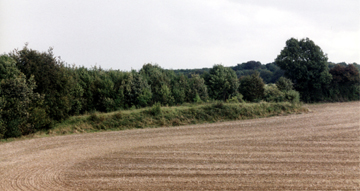
Display Contents
Neolithic burials on Thanet
Curator's introduction
Thanet longbarrows
Thanet flat graves

Julieberrie's Grave Earthen longbarrow, Chilham, Kent
Neolithic
burials are rare finds on Thanet and
in the rest of Kent
Both house a chamber which usually contain disarticulated human remains. This chamber is often covered by a long, linear mound flanked by side ditches. The excavation of these ditches provides the material to create the covering mound.
Click here
if you
would like to read an explanation on what exactly is a longbarrow,
what it comprises and what form a Thanet longbarrow might take.
The information below comprises the current state of our knowledge concerning identified and possible Neolithic burials on the Isle of Thanet (maps forthcoming).
The traditional form of
communal burial monument which we would expect to find in this area is
the longbarrow. None have
been certainly
identified by modern excavation, but aerial photography has identified
five potential
sites.
Click here to link to a page which has some more information on these sites.
Click here to link to a page which has some more information on these sites.
The burial of individuals in the Neolithic is conventionally regarded as
unusual in a period where communal monuments
containing the disarticulated remains of many people dominate the
record.
However in Thanet the only excavated evidence we have of our Neolithic ancestors' burial rites comprise flat-graves containing single, complete inhumations sometimes accompanied by other disarticulated bones. One should be careful not to be too ready to apply traditions found in other well published parts of the Country to one's own area if the evidence is lacking!
Currently two certain examples of Neolithic flat grave/pit burials are recorded. There are also several other possible candidates.
Click here to link to a page containing more information on these sites.
However in Thanet the only excavated evidence we have of our Neolithic ancestors' burial rites comprise flat-graves containing single, complete inhumations sometimes accompanied by other disarticulated bones. One should be careful not to be too ready to apply traditions found in other well published parts of the Country to one's own area if the evidence is lacking!
Currently two certain examples of Neolithic flat grave/pit burials are recorded. There are also several other possible candidates.
Click here to link to a page containing more information on these sites.
Some of the early examples may reflect an evolution of Neolithic traditions in monument design (influenced by the causewayed Henge) and burial rites (formerly characterised by multiple and disarticulated inhumations and also featuring burial on the base of ditches).
The precise dating that would help to place many of the monuments or their burial-related phases in their period context is unfortunately lacking at the moment.
To explore this phenomena further please visit the Roundbarrow Display in the Bronze Age Gallery, or click here to go straight to the Display on the Causewayed ring-ditches and roundbarrows of Thanet.
KSMR - Kent Sites and Monuments Record.
TSMR - Thanet Sites and Monuments Record.
Anderson T. 1995. Monkton in Canterbury's Archaeology 1995-96. Canterbury Archaeological Trust.
Ashbee P. 2005. Prehistoric Kent. Tempus.
Ashbee P. and Dunning G. 1960. The roundbarrows of East Kent. Archaeologia Cantiana LXXIV.
Bennet P. et al 1996. Interim report
on excavations in advance of the dualling
of the A253 between Monkton and
Birch D., Boakes P., Elworthy S., Hollins C. and Perkins D.R.J. 1987. The Gateway Island - Archaeological Discoveries in Thanet 1630-1987. Thanet Archaeological Unit.
Darvill T. 1987. PrehistoricDunning G.C. 1966. Neolithic occupation sites in East Kent. The Antiquaries Journal - Part 1.
Fisk P.M. 2003. An examination of the excavated ring ditch enclosures on The Isle of Thanet. Unpublished undergraduate dissertation.
Harrison E. 1943. Report for the year ended 31st. December 1942. Archaeologia Cantiana LVI, xxxiii.
Lewis J. 1736. The History and Antiquities, as well Ecclesiatical as Civil, of the Isle of Tenet, in Kent. Second Edition; reprinted in a Third Edition 2005. Michael's Bookshop, Ramsgate.
Lynch F. 1997. Megalithic Tombs and Long Barrows in Britain. Shire.
Mynot E. 1975. Kent Archaeological Review no.39, 254.
Shand G. 2002. Excavation at Chalk Hill, near Ramsgate 1997-98. Canterbury Archaeological Trust, integrated assessment and updated research design report.
Thanks go to Pip Fisk for the information on Neolithic burials contained in her thesis on ring-ditch monuments excavated on Thanet. This is particularly in respect of site V, which was new to me.
Many thanks also to Peter Clark of Canterbury Archaeological Trust, who's pers comm. information on the Acol and Monkton-Minster burials came from a draft copy of his summary discussion for Canterbury Trust's forthcoming report on these excavations, submitted for review and comment.
Thanks also to the Webmeister Ges Moody and Natasha Ransom for the reproduction of the Nethercourt illustrations and photograph.
Finally, much thanks go to Michael's Bookshop (Ramsgate) for reprinting John Lewis' History of the Isle of Thanet (as a Third Edition, 2005) and making the Godfather of Thanet's history books available to everyone. No home is complete without one!
Version 1 : Posted 26.09.06
Version 2 - Posted 16.12.06
All
content © Trust for Thanet Archaeology